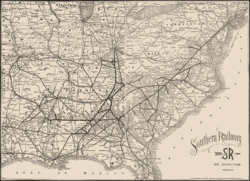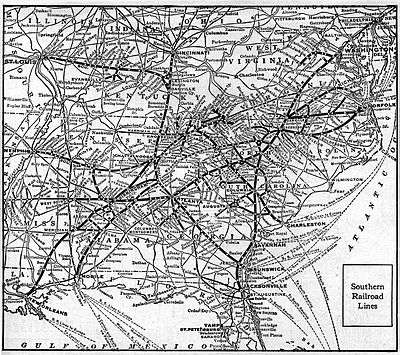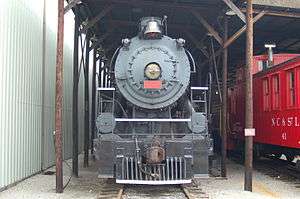Southern Railway (U.S.)
The Southern Railway (reporting mark SOU) (also known as Southern Railway Company and now known as the current incarnation of the Norfolk Southern Railway) is a name of a class 1 railroad that was based in the Southern United States. The railroad is the product of nearly 150 predecessor lines that were combined, reorganized and recombined beginning in the 1830s, formally becoming the Southern Railway in 1894.[1]
 | |
| Overview | |
|---|---|
| Headquarters | Washington, D.C. |
| Reporting mark | SOU |
| Locale | Washington, D.C., Virginia, North Carolina, South Carolina, Georgia, Florida, Alabama, Mississippi, Tennessee, Kentucky, Ohio, Illinois, Indiana, Missouri and Louisiana |
| Dates of operation | 1894–1982 |
| Successor | Norfolk Southern Railway (new name, 1982-Present) |
| Technical | |
| Track gauge | 4 ft 8 1⁄2 in (1,435 mm) standard gauge |
At the end of 1971, the Southern operated 6,026 miles (9,698 km) of railroad, not including its Class I subsidiaries Alabama Great Southern (528 miles or 850 km); Central Of Georgia (1729 miles); Savannah & Atlanta (167 miles); Cincinnati, New Orleans and Texas Pacific Railway (415 miles); Georgia Southern & Florida (454 miles); and twelve Class II subsidiaries. That year, the Southern itself reported 26,111 million net ton-miles of revenue freight and 110 million passenger-miles. Alabama Great Southern reported 3,854 million net ton-miles of revenue freight and 11 million passenger-miles; Central Of Georgia 3,595 and 17; Savannah & Atlanta 140 and 0; Cincinnati, New Orleans and Texas Pacific Railway 4906 and 0.3; and Georgia Southern & Florida 1,431 and 0.3.
The railroad joined forces with the Norfolk and Western Railway (N&W) in 1982 to form the Norfolk Southern Corporation. The Norfolk Southern Corporation was created in response to the creation of the CSX Corporation (its rail system was later transformed to CSX Transportation in 1986). Southern and N&W continued as operating companies of Norfolk Southern until 1982, when Norfolk Southern merged nearly all of N&W's operations into Southern to form the Norfolk Southern Railway. The railroad has used that name since.
History
Official Predecessors
- Richmond, York River and Chesapeake Railroad (1894)
- Richmond and Danville Railroad (1894)
- Memphis and Charleston Railroad (1894)
- East Tennessee, Virginia and Georgia Railway (1894)
- Cincinnati, New Orleans and Texas Pacific Railway (1894)
Creation and independent status


The pioneering South Carolina Canal and Rail Road Company, Southern's earliest predecessor line and one of the first railroads in the United States, was chartered on December 19, 1827, and ran the nation's first regularly scheduled steam-powered passenger train – the wood-burning Best Friend of Charleston – over a six-mile section out of Charleston, South Carolina, on December 25, 1830.[2][3] By October 1833, its 136-mile line to Hamburg, South Carolina, was the longest in the world.[2][3] The company leased enslaved African Americans from plantation owners when free white people refused to work in the swamps. The company eventually purchased 89 people to work as slaves.[4]

As railroad fever struck other Southern states, networks gradually spread across the South and even across the Appalachian Mountains. By 1857 the Memphis and Charleston Railroad was completed to link both Charleston, South Carolina, and Memphis, Tennessee.[5] The Western North Carolina Railroad was halted because voters were angry about that law allowed purchasers of private bonds to have the train tracks veer to their towns. The provision of the laws that allowed this was not repealed until Reconstruction.[6]
Rail expansion in the South was also halted with the start of the Civil War. The Battle of Shiloh, the Siege of Corinth and the Second Battle of Corinth in 1862 were motivated by the importance of the Memphis and Charleston line, the only east–west rail link across the Confederacy.[7][8] The Chickamauga Campaign for Chattanooga, Tennessee, was also motivated by the importance of its rail connections to the Memphis and Charleston and other lines. Also in 1862 the Richmond and York River Railroad, which operated from the Pamunkey River at West Point, Virginia, to Richmond, Virginia, was a major focus of George McClellan's Peninsular Campaign, which culminated in the Seven Days Battles and devastated the tiny rail link. Late in the war, the Richmond and Danville Railroad was the Confederacy's last link to Richmond, and transported Jefferson Davis and his cabinet to Danville, Virginia, just before the fall of Richmond in April 1865.[9]
Known as the "First Railroad War," the Civil War left the South's railroads and economy devastated. Most of the railroads, however, were repaired, reorganized and operated again. Convict lease was a near continuation of slavery as charges were often only applied to people of African descent. Five-hundred African Americans were assigned to provide back breaking labor on the Western North Carolina Railroad. Men were shipped to and from the worksite in iron shackles and around twenty were drowned in the Tuckasegee River weighted down by their shackles.[6] In the area along the Ohio River and Mississippi River, construction of new railroads continued throughout Reconstruction. The Richmond and Danville System expanded throughout the South during this period, but was overextended, and came upon financial troubles in 1893, when control was lost to financier J.P. Morgan, who reorganized it into the Southern Railway System.
Southern Railway came into existence in 1894 through the combination of the Memphis and Charleston Railroad, the Richmond and Danville system and the East Tennessee, Virginia and Georgia Railroad. The company owned two-thirds of the 4,400 miles of line it operated, and the rest was held through leases, operating agreements and stock ownership. Southern also controlled the Alabama Great Southern and the Georgia Southern and Florida, which operated separately, and it had an interest in the Central of Georgia.[1] Additionally, the Southern Railway also agreed to lease the North Carolina Railroad Company, providing a critical connection from Virginia to the rest of the southeast via the Carolinas.[10]
Southern's first president, Samuel Spencer, brought more lines into Southern's organized system.[11] During his 12-year term, the railway built new shops at Spencer, North Carolina, Knoxville, Tennessee, and Atlanta, Georgia, upgraded tracks, and purchased more equipment.[11] He moved the company's service away from an agricultural dependence on tobacco and cotton and centered its efforts on diversifying traffic and industrial development.[11] On November 29, 1906, Spencer was killed in a train wreck.[12]
After the line from Meridian, Mississippi, to New Orleans, Louisiana, was acquired in 1916 under Southern's president Fairfax Harrison, the railroad had assembled the 8,000-mile, 13-state system that lasted for almost half a century.[11] Additionally, Southern have operated 6,791 miles of road at the end of 1925, but its flock of subsidiaries added 1000+ more.
In 1912, the Southern Railway leased most of its Bluemont, Virginia, branch to the newly formed Washington and Old Dominion Railway. In 1945, the Southern sold most of the remnant of the branch to the Washington and Old Dominion Railroad, the successor to the Washington and Old Dominion Railway.[13]
The Central of Georgia became part of the system in 1963, and the former Norfolk Southern Railway was acquired in 1974.[11] Despite these small acquisitions, the Southern disdained the merger trend when it swept the railroad industry in the 1960s, choosing to remain a regional carrier. In 1978 President L. Stanley Crane[14][15] said the refusal to add routes through merger was a mistake, especially the decision not to add a connecting route to Chicago.[16]
The Southern tried to gain access to Chicago by targeting the Monon Railroad and the Chicago and Eastern Illinois Railroad but both those railroads went to Southern's competitor, the Louisville and Nashville Railroad.[17] A decade later Crane tried to rectify the situation by merging with the Illinois Central Railroad.[18] When that failed, he petitioned the Interstate Commerce Commission to give Southern the old Monon routes and the old Atlantic Coast Line route from Jacksonville to Tampa by way of Orlando among other properties as a condition of the I.C.C.'s approval of the Seaboard Coast Line - Chessie System merger in 1979. While the request was supported by the I.C.C.'s Enforcement Bureau, it was ultimately unsuccessful.[19]
Becoming part of the Norfolk Southern Corporation
In response to the creation of the CSX Corporation in November 1980, the Southern Railway joined forces with the Norfolk and Western Railway and formed the Norfolk Southern Corporation in 1980 which began operations in 1982, further consolidating railroads in the eastern half of the United States.[20][21]
The Southern Railway was renamed Norfolk Southern Railway as the Norfolk and Western Railway became a subsidiary to its system on June 1, 1982.[21][22] The railroad then acquired more than half of Conrail on June 1, 1999.[21]
Notable features
Southern and its predecessors were responsible for many firsts in the industry. Starting in 1833, its predecessor, the South Carolina Canal and Rail Road, was the first to carry passengers, U.S. troops and mail on steam-powered trains[23] and experimented with railroad lighting. They had a pine log fire on a flatcar, covered in sand, to provide light at night before inexpensive kerosene was invented for lamps.[24]
In 1939, the Southern Railway went under dieselization and became the first major railroad in the United States to be fully converted from steam to diesel-powered locomotives in 1953.[11][25] On January 20, 1953, the last steam-powered passenger train arrived in Knoxville, Tennessee.[26] On June 17, 1953, the railroad's last steam-powered freight train arrived in Chattanooga, Tennessee.[27][28] Although a handful of steam locomotives such as the As-11 class 0-8-0s and Ms-4 class 2-8-2s were in storage until 1954.
The Southern Railway was active in mechanization, used bank engines, is widely credited with inventing unit trains for coal and new freight cars,[29] and understood the power of marketing using the promotional phrase "Southern Gives a Green Light to Innovation".[30]
In 1966, a popular steam locomotive excursion program was instituted under the presidency of W. Graham Claytor, Jr., and included Southern veteran locomotives No. 630, No. 722,[31] No. 4501, and Savannah & Atlanta No. 750 along with non-Southern locomotives such as Texas & Pacific No. 610,[32] Canadian Pacific No. 2839,[33] and Chesapeake & Ohio No. 2716.[34] The steam program continued after the 1982 merger with the Norfolk and Western to form the Norfolk Southern, through increased operating costs and concerns ended the program in 1994.[34][35] Norfolk Southern reinstated the steam program on a limited basis from 2011 to 2015, as the 21st Century Steam program.
In the early 2000s, a 22-mile (35 km) loop of former Southern Railway right-of-way encircling central Atlanta neighborhoods was acquired and is now the BeltLine trail.
Passenger trains

Along with its famed (Southern) Crescent and Southerner, the Southern's other named trains included:[36]
- Aiken-Augusta Special
- Airline Belle
- Asheville Special
- Birmingham Special
- Carolina Special
- Fast Mail "Old 97"
- Florida Sunbeam
- Goldenrod
- Kansas City–Florida Special
- Land of the Sky Special
- Memphis Special
- New Yorker
- Peach Queen
- Pelican
- Piedmont Limited
- Ponce de Leon
- Queen and Crescent Limited
- Royal Palm
- Skyland Special
- Sunnyland
- Tennessean
The Southern Railway also handled ticket sales and operations for subsidiary railroads, such as:
- The Nancy Hanks (operated by Central of Georgia Railway)[37]
- The Man O' War (operated by Central of Georgia Railway)
The Southern Railway also participated in the operation of the City of Miami, which was operated by the Southern Railway over the Central of Georgia trackage from Birmingham, Alabama, to Albany, Georgia, where it traded off with the Seaboard Coast Line until its discontinuation in 1971.
When Amtrak took over most intercity rail service in 1971, Southern initially opted out of turning over its passenger routes to the new organization. However, it shared operation of its flagship train, the New Orleans-New York Southern Crescent, with Amtrak. Under a longstanding haulage agreement inherited from Penn Central and the Pennsylvania Railroad, Amtrak carried the train north of Washington. By the late 1970s, growing revenue losses and equipment-replacement expenses convinced Southern it could not continue in the passenger business. It handed full control of its passenger routes to Amtrak in 1979.
Roads owned by the Southern Railway
- Alabama Great Southern Railway (AGS)
- Albany and Northern Railway (A&N)
- Atlantic & Eastern Carolina Railway (A&EC)
- Birmingham Terminal Company
- Camp Lejeune Railroad Company
- Carolina and Northwestern Railway (C&NW)
- Central of Georgia Railway (CofG)(CG)
- Cincinnati, New Orleans and Texas Pacific Railway (CNO&TP)
- Chattanooga Station Company
- Chattanooga Traction Company (CTC)
- Georgia and Florida Railroad (G&F)
- Georgia Ashburn Sylvester and Camilla Railway (GAS&C)
- Georgia Northern Railway (GANO) — acquired in 1967
- Georgia Southern and Florida Railway (GS&F)
- Interstate Railroad (INT)
- Kentucky and Indiana Terminal Railroad (K&IT)
- Sievern and Knoxville Railroad
- Live Oak Perry and Gulf Railway (LOP&G)
- Louisiana Southern Railway (LS)
- New Orleans and North Eastern Railway (NO&NE)
- New Orleans Terminal Company (NOTCO)
- Norfolk Southern Railway (NS)
- Savannah & Atlanta Railway (SA)
- Saint John's River Terminal Company (SJRT)
- State University Railroad Company (54%)
- South Georgia Railway (SG)
- Tennessee, Alabama and Georgia Railway (TA&G)
- Tennessee Railway (TENN)
Major railroad yards
- Chattanooga, Tennessee – DeButts Yard (formerly Citico Yard)
- Atlanta, Georgia – Inman Yard
- Spencer, North Carolina – Spencer Yard
- Birmingham, Alabama – Norris Yard
- Knoxville, Tennessee – Sevier Yard
- Macon, Georgia – Brosnan Yard[38]
- Sheffield, Alabama – Sheffield Yard
- Alexandria, Virginia – Potomac Yard
Company officers
Presidents of the Southern Railway:
- Samuel Spencer (1894–1906)[39]
- William Finley (1906–1913)
- Fairfax Harrison (1913–1937)
- Earnest E. Norris (1937–1951)
- Harry A. DeButts (1951–1962)
- D. William Brosnan (1962–1967)
- W. Graham Claytor, Jr. (1967–1977)[40][41]
- L. Stanley Crane[14][15] (1977–1980)
- Harold H. Hall (1980–1982)
Heritage unit
To mark its 30th anniversary, Norfolk Southern painted 20 new locomotives with the paint schemes of predecessor railroads. GE ES44AC #8099 was painted in Southern Railway's green and white livery.[42][43]
See also
- FM OP800
- List of Southern Railway locomotives
- Southern Railway's Spencer Shops
References
- "Southern Railway History". SOUTHERN RAILWAY HISTORICAL ASSOCIATION. SOUTHERN RAILWAY HISTORICAL ASSOCIATION. March 5, 2017. Retrieved March 12, 2017.
- Marrs, Aaron W. "South Carolina Railroad: December 19, 1827–1902". South Carolina Encyclopedia. Archived from the original on April 19, 2019. Retrieved April 19, 2019.
- Loy, Hillman & Cates (2004), p. 7.
- Ulrich Bonnell Phillips (1908). Transportation in the Ante-bellum South: An Economic Analysis. Ulrich Bonnell Phillips. pp. 148–153.
- Harper's Encyclopædia of United States History from 458 A.D. to 1905: Based Upon the Plan of Benson John Lossing ... Harper & brothers. 1906. p. 526.
- Sue Greenberg; Jan Kahn (January 1997). Asheville: A Postcard History. Arcadia Publishing. p. 10. ISBN 978-0-7524-0807-1.
- Cozzens, Peter (1997). The Darkest Days of the War The Battles of Iuka&Corinth. North Carolina: The University of North Carolina Press. pp. 18–19. ISBN 978-0-8078-5783-0.
- Hamilton, Charles Smith (1882). "Correspondence in regard to the battle of Corinth, Miss., October 3d and 4th, 1862".
- John Stewart (December 11, 2014). Jefferson Davis’s Flight from Richmond: The Calm Morning, Lee’s Telegrams, the Evacuation, the Train, the Passengers, the Trip, the Arrival in Danville and the Historians’ Frauds. McFarland. p. 28. ISBN 978-1-4766-1640-7.
- North Carolina. Board of Railroad Commissioners (1895). Annual Report of the Board of Railroad Commissioners of North Carolina. J. Daniels, state printer. pp. IV–XIII.
- Loy, Hillman & Cates (2004), p. 8.
- "Samuel Spencer Killed In Wreck". The New York Times. November 30, 1906. Archived from the original on June 20, 2018. Retrieved April 20, 2019.
- (1) Harwood, Herbert H., Jr. (April 2000). Rails to the Blue Ridge: The Washington and Old Dominion Railroad, 1847 – 1968 (PDF) (3rd ed.). Fairfax Station, Virginia: Northern Virginia Parks Authority. pp. 45–46, 90. ISBN 0615114539. LCCN 77104382. OCLC 44685168. Archived from the original (PDF) on September 28, 2017. In Appendix K of Northern Virginia Regional Park Authority - Pre-filed Direct Testimony of Mr. Hafner, Mr. Mcray and Mr. Simmons, November 30, 2005 (Part 5), Case No. PUE-2005-00018, Virginia State Corporation Commission. Obtained in "Case Docket Search". Virginia State Corporation Commission. Retrieved September 28, 2017.
(2) Williams, Ames W. (1989). The Washington and Old Dominion Railroad. Arlington, Virginia: Arlington Historical Society. p. 94. ISBN 0926984004. OCLC 20461397.CS1 maint: ref=harv (link) - "NAE Website - Mr. L. Stanley Crane".
- L. Stanley Crane (born in Cincinnati, 1915) raised in Washington, lived in McLean before moving to Philadelphia in 1981. He began his career with Southern Railway after graduating from The George Washington University with a chemical engineering degree in 1938. He worked for the railroad, except for a stint from 1959 to 1961 with the Pennsylvania Railroad, until reaching the company's mandatory retirement age in 1980. Crane went to Conrail in 1981 after a distinguished career that had seen him rise to the position of CEO at the Southern Railway. He died of pneumonia on July 15, 2003, at a hospice in Boynton Beach, Florida
- "DEADLINE SET ON RAIL MERGER" (PDF). U.S.Government Publishing Office. U.S.Government Publishing Office. June 30, 1980. Retrieved May 12, 2017.
The purpose of the agency is to give railroads an opportunity to purchase portions of the Chessie and Seaboard systems. Cited as an example was the Southern Railroad's interest in the Louisville & Nashville line between Louisville, Ky., and Chicago, Ill. 'There may be other examples where parties have been unable to agree on specific terms such as price of properties and operational arrangements because of a failure to communicate adequately,' the agency said.
- "Monon, L&N. Roads Act to Merge". Chicago Tribune. Chicago, Illinois. March 22, 1968. Retrieved May 12, 2017.
- "Southern Dreams of Chicago". Chicago Tribune. Chicago, Illinois. July 5, 1978. Retrieved May 12, 2017.
- April 8, 1978 "I.C.C. URGED TO SPLIT SEABOARD COAST LINE". The New York Times. New York, New York. April 8, 1978. Retrieved May 12, 2017.
- "Southern Rail, N&". The Washington Post. February 22, 1982. Archived from the original on May 19, 2018. Retrieved May 19, 2018.
- "Norfolk Southern merger family tree". Trains. June 2, 2006. Archived from the original on July 19, 2017. Retrieved May 19, 2018.
- Davis (1985), p. 165.
- Brown, William H. (1871). "Chapter XXIX: Explosion of "Best Friend"". The History of the First Locomotives in America; From Original Documents And The Testimony Of Living Witnesses. New York: D. Appleton and Company. Archived from the original on November 26, 2001. Retrieved May 28, 2008.
- Christian Wolmar (March 2, 2010). Blood, Iron, and Gold: How the Railways Transformed the World. PublicAffairs. p. 72. ISBN 978-1-58648-851-2.
- Schafer (2000), p. 133.
- Loy, Hillman & Cates (2004), p. 10.
- Davis (1985), p. 3.
- Loy, Hillman & Cates (2004), p. 13.
- Brian Solomon; Patrick Yough (July 15, 2009). Coal Trains: The History of Railroading and Coal in the United States. MBI Publishing Company. p. 13. ISBN 978-1-61673-137-3.
- Kelly, John (April 5, 2001). "Selling the service: A look at memorable railroad slogans and heralds through the years". Classic Trains Magazine. Kalmbach Publishing. Retrieved May 16, 2017.
- Loy, Hillman & Cates (2004), p. 124.
- Loy, Hillman & Cates (2005), p. 114.
- Loy, Hillman & Cates (2005), p. 123.
- Schafer (2000), p. 134.
- Phillips, Don (October 29, 1994). "Norfolk Southern plans to end nostalgic steam locomotive program". The Washington Post. Archived from the original on November 30, 2016. Retrieved March 11, 2017.
- Schafer (2000), pp. 127-132.
- Loy, Hillman & Cates (2004), p. 93.
- Loy, Hillman & Cates (2004), p. 54.
- "The History of the railroad and Spencer". North Carolina Transportation Museum. Archived from the original on February 5, 2007. Retrieved January 25, 2007.
- White, John H. Jr. (Spring 1986). "America's Most Noteworthy Railroaders". Railroad History. 154: 9–15. ISSN 0090-7847. JSTOR 43523785. OCLC 1785797.
- quotes from article by journalist Don Phillips of the Washington Post in a "Tribute to W. Graham Claytor, Jr." published May, 1994
- Heritage Locomotives Norfolk Southern
- Norfolk Southern Heritage Locomotives Norfolk Southern
Bibliography
- Davis, Burke (1985). The Southern Railway: Roads of the Innovators (1st ed.). The University of North Carolina Press. ISBN 0-8078-1636-1.CS1 maint: ref=harv (link)
- Loy, Sallie; Hillman, Dick; Cates, C. Pat (2004). The Southern Railway. Images of Rail (1st ed.). Arcadia Publishing. ISBN 978-0-7385-1641-7.CS1 maint: ref=harv (link)
- Loy, Sallie; Hillman, Dick; Cates, C. Pat (2005). The Southern Railway: Further Recollections. Images of Rail (1st ed.). Arcadia Publishing. ISBN 978-0-7385-1831-2.CS1 maint: ref=harv (link)
- Schafer, Mike (2000). More Classic American Railroads (1st ed.). Voyageur Press. ISBN 0-7603-0758-X.CS1 maint: ref=harv (link)
Further reading
- The Historical Guide to North American Railroads, Third Edition (3rd ed.). Kalmbach Publishing. 2014. pp. 273–275. ISBN 978-0-89024-970-3.
- Murray, Tom (2007). Southern Railway. MBI Railroad Color History (1st ed.). Voyageur Press. ISBN 978-0-7603-2545-2.CS1 maint: ref=harv (link)
- Prince, Richard E. (1970). Steam Locomotives and Boats: Southern Railway System (2nd ed.). Wheelwright Lithographing Company. ISBN 0-9600088-4-5.CS1 maint: ref=harv (link)
External links
| Wikimedia Commons has media related to Southern Railway (US). |
- Norfolk Southern company website
- Southern Railway Historical Association covers Southern Railway history
- Virginia Museum of Transportation located in Roanoke, VA
- Johnson's Depot: Railway History of Johnson City, TN
- Railroad lines abandoned by the Southern Railway
- Annual Report of Southern Railway Company in Mississippi (MUM00010) at The University of Mississippi.
- Harrison, Fairfax. A History of the Legal Development of the Railroad System of Southern Railway Company. Washington, D.C.: 1901. (A Google eBook)
- Norfolk Southern Railway. Retrieved February 22, 2005.
- Named Trains
- SOUTHERN Railfan
- Passenger Coach No. 3780 historical marker
- Documents and clippings about Southern Railway in the 20th Century Press Archives of the ZBW
